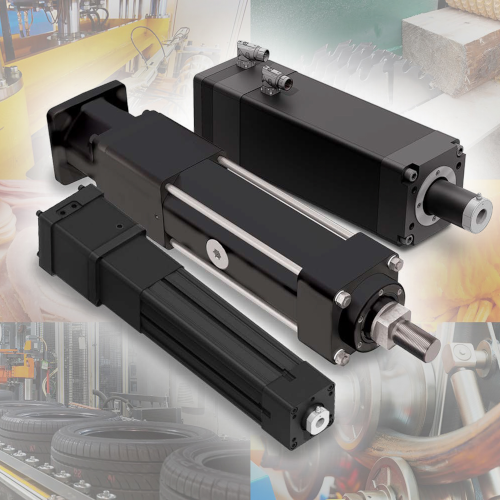
A linear actuator is usually needed to move an object in a straight line, from a conveyor to a metal press. While some applications requiring the highest forces and longest strokes might need hydraulic actuation, in the majority of cases, electromechanical actuator technology provides both machine builders and machine users with significant advantages.
Gerard Bush, INMOCO, compares electric and hydraulic actuator technology.
Electric actuators today provide mechanical outputs sufficient to span a wide variety of applications previously considered achievable only with hydraulic power. Compared to hydraulic, they offer a comparable bore size, extending from 25mm up to 127mm, with force reaching as high as 222.4kN. While achieving the same mechanical output, the more compact size of an electric system also enables a smaller machine footprint.
One of the clearest benefits of electric actuator technology is the higher level of control it provides. Coupled with a servo drive and motor, an electric actuator gives real time motion control over position, speed, acceleration and deceleration. Whereas a hydraulic system must maintain a constant oil temperature, which can otherwise cause fluctuating viscosity that impacts performance, an electric system provides greater consistency of operation.
Constant torque monitoring means control over force that single digit percentage points can consistently measure. High accuracy position control with closed loop operation means that multiple positions can be achieved with precision without additional external sensors.
Position and speed control can be achieved with hydraulic systems but this requires the addition of servo valves. Their integration adds significant cost and complexity compared to electric systems to achieve a comparable outcome.
As a result of the risk of leakage and contamination, some industries cannot use hydraulic actuation.Stringent regulations surrounding the food and beverage industry and pharmaceutical sector make electric actuators the only choice. Hydraulic actuators leak at some point in their lifetime and the fluid can damage produce. Alternatively, electric actuators remove any concerns of leakage or contamination and they also provide far quieter operation.
Electric actuators are sealed and once installed they operate maintenance-free, aside from periodic addition of grease via a port. This operation also makes them more reliable while the relative complexity of a hydraulic system takes longer to install and demands regular maintenance.
Despite the advantages of electric actuators, perception of cost is the main reason for resistance to conversion. They are more expensive in initial capital cost and some OEMs consider this prohibitive. However, true cost over the lifetime of machinery is the total cost of ownership and these benefits can be presented to the primary beneficiaries: the end users.
Substantial energy savings can be made over a machine’s lifetime. Electric actuators are more efficient, operating at up to 80% efficiency, whereas it’s not uncommon to find hydraulic actuators that provide less than 50%. More significantly, hydraulically powered machines are less productive than their electromechanical counterparts as a result of increased downtime, combined with longer machine changeover times.
When converting to electric, the biggest mistake is to oversimplify the force calculation process. While over-sizing a hydraulic system is common, because allowing a headroom of force required comes at relatively low cost, it’s key that an electric system is sized with greater accuracy to minimise energy costs. The traditional method of sizing, the system pressure method, is not recommended because it will likely lead to oversizing. Instead, determining the true peak and continuous working force of the existing hydraulic cylinder is ideal.
The most accurate sizing can be achieved by using a load cell or temporary installation of an electric actuator. INMOCO provides a sizing service and can work with designers to achieve the optimum specification for application requirements. Tolomatic, which manufactures electric actuators, also offers customisation to provide machine builders with the flexibility they need.
Hydraulic actuators aren’t going away. The stroke length of electric actuators is limited to around one meter, whereas hydraulic actuators extend further. Similarly, hydraulic actuators feature bores up to 203mm and are able to provide nearly 500kN of force. Below these requirements, providing the actuator is accurately sized with the proper assistance, electric power provides the highest performance and most cost effective operation.




